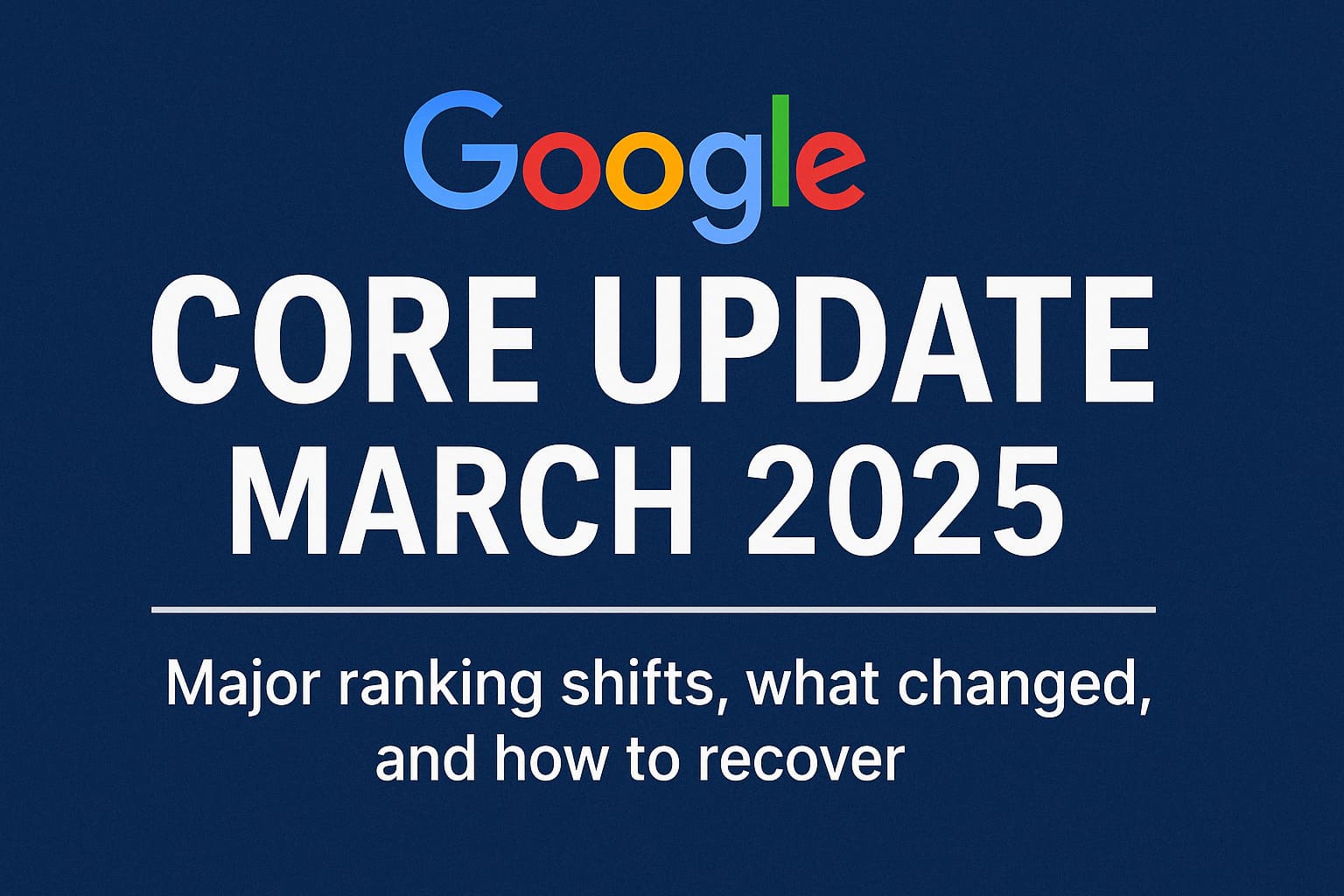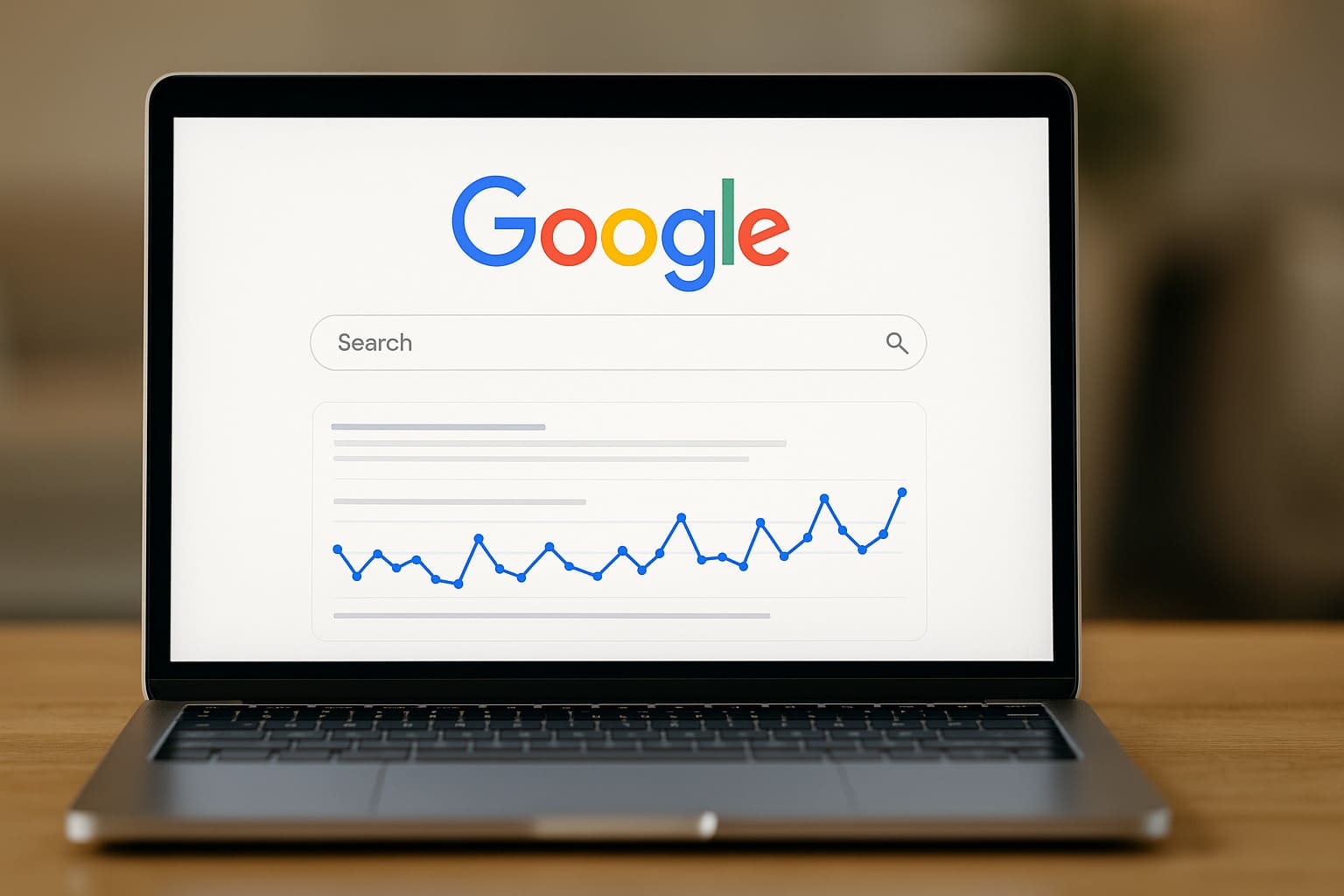Your rankings dropped fast. Your site was not broken. But something felt off.
Pages that looked helpful, sounded human, and matched search intent moved up. Others, even if well-written, slipped behind.
This was not a penalty. It was a reset of what counts as quality.
Google rolled out its March 2025 Broad Core Update on March 13. The official rollout ended by March 27, but search volatility continued well into April—with big swings on April 2, April 9, and April 15–16.
Here is the post from Google on X:
Today we released the March 2025 core update. We’ll update our ranking release history page when the rollout is complete: https://t.co/QoqMDbJu3D
— Google Search Central (@googlesearchc) March 13, 2025
These later shifts were not random. They were part of Google’s trust recalibration phase, where its systems—like the Helpful Content Classifier, Core Ranking Model, and Search Intent Signals—were re-balancing your entire domain’s value.
If your content looked templated, outdated, or disconnected from real experience, it likely dropped.
If it had strong authorship, clarity, and intent-match, it likely climbed.
Google March 2025 Core Update: Quick Facts
| Detail | Insight |
| Name | March 2025 Broad Core Update |
| Launch Date | March 13, 2025 (12:30 PM ET) |
| Rollout Duration | About 2 weeks |
| What It Affects | All content types – text, product, video |
| Penalty? | No. It rewards stronger content |
| Global Reach | Yes – all regions, all languages |
| System Triggered | Helpful Content System + Core Ranking Engine |
| Search Surface | Impacts Discover, snippets, rankings |
| Fix Path | Improve depth, author clarity, and topical strength |
| Next Update? | Yes. Future rollouts may occur silently |
This update was not about removing weak pages. It was about replacing them with something more helpful. If your site dipped, you were not alone. But now you know why—and where to begin.
What Changes in the March 2025 Google Core Update?
You kept your content clean. You answered real questions. Still, your rankings fell. The problem was not your effort. It was the signals Google now listens to.
This update redefined what “good content” means. It did not focus on speed or backlinks. It focused on who is speaking, what they are saying, and whether the user leaves with a clear answer.
Google Prioritized Content That Helps—Not Just Exists
The Helpful Content System now runs all the time. It reviews your entire domain—not just a post. If half your site feels outdated, copied, or vague, the rest may drop with it.
What moved up:
- Clear, structured answers
- Updated pages that meet search intent
- Content with proof of experience—not just opinions
What moved down:
- Posts written “for SEO” without solving a real user need
- Pages with no author, no bio, no sources
- Text that reads like it was built to rank—not to help
E-E-A-T Got Stronger—And Broader
Google expanded its E-E-A-T weighting. It is no longer enough to sound right. You must prove you know the topic.
Here is what now gets you trust:
- Experience shown through real-life examples
- A visible author with expertise in that niche
- Sources that link to credible data, not recycled fluff
- An updated date, not a publish-and-forget page
Even one line like “We used this framework last quarter to grow leads by 43%” builds trust better than five paragraphs of theory.
Lazy AI Content Quietly Faded
This update did not punish AI content. It ignored it—if it felt rushed, soulless, or mass-produced.
Pages that looked like templates stitched together for traffic were skipped. Content that blended human edits, insight, and formatting held its ground.
Search Intent Became the Gatekeeper
Google is now tighter about intent alignment. If someone searched how to improve rankings, and your page taught what rankings mean, you lost visibility.
Each search now expects a precise experience match. The bar is higher, but clearer.

Why So Many Good Sites Dropped
You fixed your content. You followed the rules. Still—traffic fell off a cliff. That is what frustrated creators the most. The March 2025 core update did not punish spam. It stopped rewarding pages that felt replaceable.
“Core updates don’t target specific pages or sites. They’re about improving how our systems assess content overall. These changes may cause some pages that were previously under-rewarded to perform better, while others may do less well.”
— Google Search Help
Smaller Sites Lost First—Not Because They Were Wrong
Google now reads your entire site like a trust profile. Every page counts. If too many posts feel thin, repetitive, or unloved—even your strongest content loses momentum.
Blogs, info hubs, and personal sites often lacked:
- Updated timestamps
- Named authors with credentials
- Clear internal linking that signals content depth
- Trust-building citations
Even if the answers were useful, they lacked the site reputation signals Google needs to feel confident ranking you over a more polished domain.
You wrote a great post. But your author page was empty. Your last update was a year ago. And your “resources” link pointed to a homepage. Google noticed.
AI-Scaled Sites Lost the Battle for Believability
Sites that pushed out hundreds of AI-written pages saw steep drops—especially when content:
- Lacked editing or formatting
- Felt stitched together for keywords
- Had no real point-of-view
This update was not anti-AI. It was anti-autopilot. Google’s Helpful Content Classifier and Content Provenance Signals demoted pages that felt manufactured, even if technically optimized.
Pages Without People Lost Presence
If your content had no author, no byline, and no source attribution—it read like digital wallpaper. And in 2025, that matters.
Google strengthened authorship trust mapping. Pages with named writers, a clear About page, and external validation held up. Pages with generic names like “Team” or “Staff Writer” faded.
One real sentence like:
“I run a photography studio in Delhi—this is how we track leads from Google Maps.”
…can do more for trust than 800 words of fluff.
Thin Affiliate and Roundup Pages Collapsed
Sites built on product roundup templates, especially those with:
- Stock images
- No hands-on experience
- No real product citations
…saw major drops. Google now checks if content is first-hand or derivative.
This aligns with the Content Provenance Classifier, which evaluates originality, visual signals, and embedded links to assess value.
March Set the Stage. April Confirmed the Fallout.
Your rankings may have dipped after March 27. That is not a mistake.
Google’s Indexing Reassessment Phase kicked in across April 2, 9, and 15–16, where it fine-tuned ranking based on:
- Crawl budget decay
- User interaction patterns (bounce, scroll, hover)
- Link and structure signals via SpamBrain’s trust modeling
If your site dipped mid-April, it was likely the slow ripple effect from March—not a separate penalty.
Why Did Small Sites Get Hit So Hard?
You followed the rules. You wrote helpful content. You stayed away from spam. Yet your rankings dropped. If that felt unfair—you are not alone.
This update did not block small sites. But it exposed a deeper problem: many small sites lacked consistent trust signals across their entire domain.
Google Now Scores the Whole Site—Not Just a Page
Think of your site as a living trust profile. One strong article can no longer carry a weak domain. If half your pages look outdated, copied, or empty, even your best work may lose visibility.
Here is what often hurt smaller sites:
- Missing author bios or a vague About page
- Posts without dates, sources, or evidence of experience
- Dozens of low-value “how-to” pages or FAQs
- Crawl budget spread too thin across content that adds little
- No strong internal links or topic clusters
Even if your posts were not wrong, Google’s Core Ranking System may have scored the entire domain as low-confidence.
Big Sites Win by Default—Small Sites Need to Prove It
Larger domains usually have:
- Dedicated content editors
- Ongoing updates and technical audits
- Strong site architecture with interlinked content
- Reputable authors and consistent E-E-A-T signals
That builds site authority by default.
Smaller sites? They need to show those signals manually—and with care.
If 1 out of every 3 pages on your site looks outdated, Google now sees that as a pattern—not an exception.
You Can Still Compete—Here’s How
Google does not block small sites. But it favors sites that look helpful from every angle.
To earn that trust:
- Make sure every post has a clear author and a reason to exist
- Link your posts together by topic, not just tags
- Remove, merge, or update any content that adds no real value
- Build site reputation signals: bios, citations, reviews, expert quotes
- Focus your crawl budget on content that truly helps
This update was not about size. It was about consistency.
And if you do the work, even a small site can rise again.
How to Recover from the March 2025 Core Update
Your traffic dropped. Your updates did not help. You kept checking—but rankings stayed flat. That is not failure. That is a signal.
The March 2025 update was not a penalty. It was a reshuffle. Pages that looked helpful, earned trust, and matched search intent climbed. Others got replaced. If you want to recover, fix what Google now values.
This is not a hack. It is a process.
Identify the Pages That Lost Visibility
Start with the 10 pages that dropped the most in Google Search Console.
Check each one for:
- Titles that over promise or mislead
- Missing author info, source links, or updated timestamps
- Posts that feel like a summary, not a solution
- Weak intros or vague subheadings
Ask: Does this page still solve a user’s real problem? If not, rewrite it.
Add Clarity, Not Just More Words
Google is looking for pages that help—not pages that speak longer.
Fix each post by:
- Adding a real example, data point, or personal line
- Replacing fluff with direct answers up front
- Breaking blocks into short, readable chunks
- Updating broken links, screenshots, or product names
Read your content out loud. If it sounds robotic, it needs a voice.
Strengthen E-E-A-T Across Your Domain
Google checks trust signals site-wide. Even one weak page can affect others.
To boost your E-E-A-T:
- Add a short author bio to every post
- Write an About page that feels personal
- Link to credible sources, not vague pages
- Show experience in your writing, even with one sentence
Example: “I tested this tool on two projects in January—it saved time both times.”
That line builds more trust than 500 words of fluff.
Clean or Combine Weak Content
Old, thin, or duplicate pages hold your site back.
- Merge overlapping posts into single, stronger pages
- Redirect anything outdated or off-topic
- Delete “near-duplicate” pages that repeat the same ideas
A smaller site with 25 strong pages ranks better than one with 300 low-value ones.
Wait, Track, and Adjust
Once you update key pages:
- Wait 2–3 weeks. Google needs time to re-crawl and re-rank
- Use Search Console: Watch impressions and keyword shifts
- Use GA4: Check time on page, exit rate, engagement
- Use rank trackers: Spot trend changes, not day-to-day noise
Recovery is not instant. But with focused updates, most sites improve in 30–45 days.
Fix what helps readers. Show proof you know the topic. Remove what holds your site back. That is how Google sees value—and that is how you earn your spot again.
Google’s Helpful Content System and E-E-A-T in 2025
If your rankings dropped, it may not be because your content was wrong. It may be because your site felt unfinished, unhelpful, or untrustworthy.
In 2025, Google does not just read your content—it reads your intent. Two things now shape your rankings: the Helpful Content System and E-E-A-T.
Helpful Content System Now Runs in Real Time
Google’s Helpful Content System never stops running. It constantly checks if your site helps people or exists just to rank.
Here is what it watches:
- Are your pages written for users or for bots?
- Does your content offer real answers or vague summaries?
- Are old, thin pages still live that drag your domain down?
Even if you have a few great blogs, your site can still drop if many pages feel weak or outdated. This system looks at your entire site.
To rank again, focus on:
- Writing clearly and directly
- Fixing or removing pages that no longer serve the reader
- Making each post easier to scan and trust
E-E-A-T Is No Longer Optional
E-E-A-T stands for:
- Experience – Have you done what you are teaching?
- Expertise – Do you know the topic?
- Authoritativeness – Can others trust your advice?
- Trust – Does your content feel safe and honest?
In 2025, Google expects every important page—especially in topics like money, health, or tech—to show strong E-E-A-T signals.
Here is what boosts those signals:
- A short author bio with a real name
- A helpful About page that shows who you are
- Clear sources and updated facts
- A tone that shows you have done this—not guessed it
If your site feels faceless or generic, it will lose visibility. But if your content sounds like it came from someone real, it has a better chance to rank—even if the site is small.
These Two Systems Work Together
Google now asks two core questions about your content:
- Is this page helpful?
- Is it trustworthy?
You need to answer yes to both. Keywords alone will not help anymore.
What helps?
- A calm, clear voice
- Examples from your real work
- A layout that guides people, not just search crawlers
When you write to help, structure to be clear, and sound like a person—Google notices.
Ranking Volatility Timeline and What It Means
The March 2025 core update officially ended on March 27, but the story did not stop there. Many site owners saw strange drops, rebounds, and ranking jumps weeks later. If that happened to you, it was not a glitch. It was Google retesting and rebalancing trust.
Real Timeline of Ranking Volatility
- March 13: Core update launched
- March 27: Google confirmed rollout completed
- April 2: First wave of ranking volatility
- April 9: Second round of traffic shifts
- April 15–16: Final surge of movement
These dates mark when Google recalibrated its trust signals using the updated Helpful Content System and E-E-A-T checks. It re-evaluated content freshness, user experience, and author credibility—not just keywords.
Why These Spikes Matter
Each volatility spike shows that Google’s updates do not end with the rollout. The algorithm keeps adjusting for content freshness, trustworthiness, and search intent match. That is why some rankings dropped late or jumped without warning.
If your site dipped during these periods, here is what it likely means:
- Your content was not updated enough
- It lacked clear author info or expertise signals
- The intent did not match what the user expected
- You got temporarily outranked by stronger domain signals
These are not penalties. They are part of how Google tests which content holds up under pressure.
What You Should Track and When
To spot changes early, focus on these tools:
- Google Search Console: Watch for drops in impressions and click-through rates by page and query
- Google Analytics 4: Monitor changes in time on page, bounce rate, and session depth
- Rank Trackers (SEMrush, Ahrefs, Nightwatch): Use keyword-level tracking to map shifts against update dates
Use these tools during and after volatility windows. They show you how your pages responded to reindexing, freshness tests, and trust signal shifts.
How This Helps You Act Faster
When you understand that ranking volatility is part of rebalancing—not chaos, you stop chasing daily shifts. Instead, you watch for patterns tied to known events.
That is how you make smarter updates.
That is how you recover faster next time.
Tools to Track Core Update Impact
When your traffic drops or rankings shift, guessing is the worst move. You need real data. These tools help you track what changed, where it happened, and why it matters.
Google’s core updates do not work instantly. They unfold in phases—starting with rollout, followed by reindexing, trust recalibration, and late-stage intent filtering. The right tools help you see that full picture.
1. Google Search Console
This is your direct link to what Google sees.
Use it to monitor:
- Impressions (visibility on search pages)
- Clicks (real engagement)
- Top Queries (intent shifts)
- Coverage Reports (indexation issues)
- Enhancements Tab (page experience and schema problems)
Check for changes before, during, and two weeks after any core update window.
2. Google Analytics 4 (GA4)
GA4 tells you how people behave once they land on your site.
Track:
- Time on Page – lower times suggest content mismatch
- Engagement Rate – shows how useful your content feels
- Traffic Sources – which pages or channels dropped
- Top Exit Pages – where users lose interest
If visitors leave early, the content may not match search intent or feel trustworthy enough to continue.
3. Rank Trackers (Nightwatch, SEMrush, Ahrefs, SE Ranking)
These tools help you track keyword rankings by page, device, and location. Use them to:
- Monitor keyword shifts around update dates
- Compare your top competitors
- Identify sudden losses tied to ranking volatility windows
Match dips in position to update timelines. If a keyword fell on April 2 or April 9, you know it was tied to Google’s recalibration window.
4. Visual Volatility Sensors
Use tools like:
- Mozcast
- SERPmetrics
- Cognitive SEO Signals
These tools show when Google’s results are shifting heavily. High volatility days signal major algorithm testing or re-scoring.
Track these trends. They give you early warnings.






